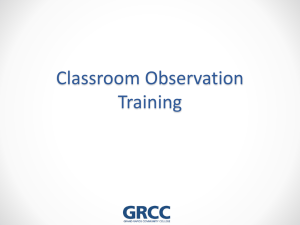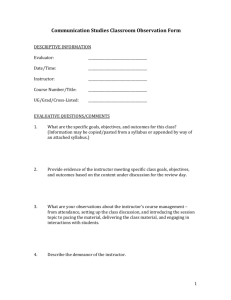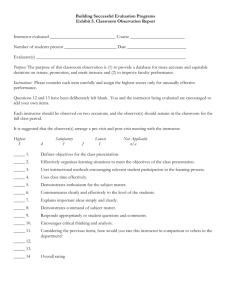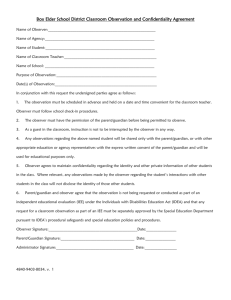How to Document What You Observe
advertisement
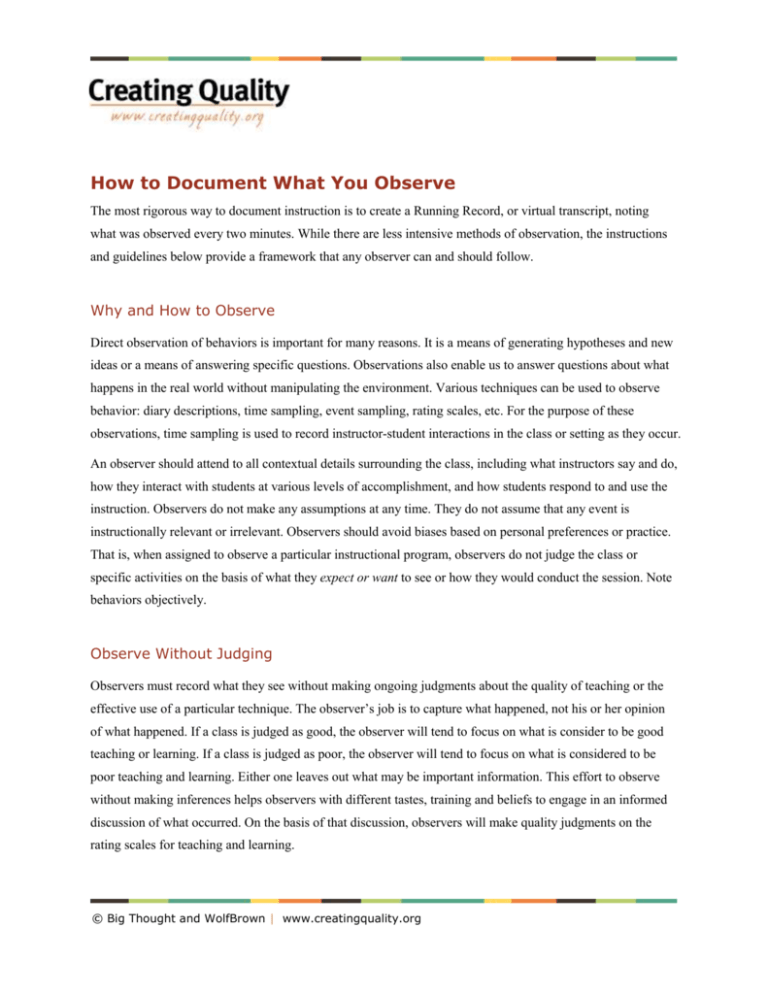
How to Document What You Observe The most rigorous way to document instruction is to create a Running Record, or virtual transcript, noting what was observed every two minutes. While there are less intensive methods of observation, the instructions and guidelines below provide a framework that any observer can and should follow. Why and How to Observe Direct observation of behaviors is important for many reasons. It is a means of generating hypotheses and new ideas or a means of answering specific questions. Observations also enable us to answer questions about what happens in the real world without manipulating the environment. Various techniques can be used to observe behavior: diary descriptions, time sampling, event sampling, rating scales, etc. For the purpose of these observations, time sampling is used to record instructor-student interactions in the class or setting as they occur. An observer should attend to all contextual details surrounding the class, including what instructors say and do, how they interact with students at various levels of accomplishment, and how students respond to and use the instruction. Observers do not make any assumptions at any time. They do not assume that any event is instructionally relevant or irrelevant. Observers should avoid biases based on personal preferences or practice. That is, when assigned to observe a particular instructional program, observers do not judge the class or specific activities on the basis of what they expect or want to see or how they would conduct the session. Note behaviors objectively. Observe Without Judging Observers must record what they see without making ongoing judgments about the quality of teaching or the effective use of a particular technique. The observer’s job is to capture what happened, not his or her opinion of what happened. If a class is judged as good, the observer will tend to focus on what is consider to be good teaching or learning. If a class is judged as poor, the observer will tend to focus on what is considered to be poor teaching and learning. Either one leaves out what may be important information. This effort to observe without making inferences helps observers with different tastes, training and beliefs to engage in an informed discussion of what occurred. On the basis of that discussion, observers will make quality judgments on the rating scales for teaching and learning. © Big Thought and WolfBrown | www.creatingquality.org Gauging the Level of Detail Another difficult issue when observing is determining what to include and what to leave out of a running record. For example, should an instructor’s position or tone of voice be included? Observers need to use common sense and have some knowledge of what behaviors are of interest. Should the observer record what the instructor says to students during a particular lesson? Should the observer record what the students are saying? When trying to create a detailed picture of teaching and learning in the arts, it is extremely important that observers collect specific directions, discussions, comments and feedback (from both adults and students) when they can. They will not be able to capture it all; instead, make informed choices. An instructor’s feedback to students or students’ questions to an instructor are more important than the interpersonal chat that may occur between students. The specifics captured will ultimately provide information from which observers will make rating judgments that become data in the evaluation. Although there is no clear-cut definition of what should or should not be recorded, the rule of thumb is to record as much of the occurring behaviors observed that are needed to provide a clear picture of what is occurring. The optimal means of recording information would be to use video recorders, but many issues make that infeasible. So, the task for observers is to record what they observe so that anyone who was not in the classroom will still get a meaningful picture of what was seen. During an observation, the observer should: Enter the setting and sit so that the instructor, the students and any materials being used can be seen. Make notes on what is seen and heard at least every two minutes, making sure to capture those details that give information about the students’ and instructor’s thinking (e.g., not just, “the student answered,” but what did the student say or write or draw? Capture similar details for instructors.). Among other things, the Running Record should offer a view of the chain of events and the train of thought (both for individuals and across the groups in the setting). Describe for each two-minute interval: o o o o o o Observable actions (who’s talking, who’s listening, etc.) Speech/language (capture direct quotes when possible and relevant) Notations, drawings, models, etc. (recording both the forms in which problems are posed and the forms in which they are worked on) Interactions between instructor and students Materials used If/when classes break into small groups, observers should observe one small group in detail, moving as needed to hear and see well. Note the total number of students in the small group. Use “short-hand” descriptions. These can be filled in later. Emphasize specifics (directions given, questions asked, responses to student work, etc.). © Big Thought and WolfBrown | www.creatingquality.org 2 Mark events or moments that need to be discuss with colleagues or the observed instructor in order to get a clearer understanding of what occurred. Instructors’ behavior... what to look and listen for: How does the instructor set up the work of the session? How does the instructor establish the expectations and standards for good work? How does the instructor help students to explain their thinking? How does the instructor ensure that students are comfortable asking questions? How does the instructor model and encourage the use of scientific language? What strategies does the instructor use to support English-language learners or students with special needs? How does the instructor respond when a student struggles or makes a mistake? What strategies does the instructor use to engage students with different cultural backgrounds and approaches to learning? Students’ behavior... what to look and listen for: How do students respond to directions, prompts, invitations? What evidence is there that students understand and respond to the expectations and standards for good work? How well do students present and explain their thoughts, questions and choices? Are students using the concepts and ideas at the heart of the lesson? How do students respond to making mistakes or being asked to revise? How deeply engaged are students who appear to have different cultural backgrounds, language or approaches to learning? The example of descriptive notes in Figure 1 (next page) contrast poor observer notes with improved observer notes. The poor observer took limited notes, missing a time point and recording only generalities rather than specific details about the warm-up session. The improved observer’s notes included all time points and a much greater understanding of the sequence and depth of the activities that occurred. The instructor’s verbal cues to students were recorded. © Big Thought and WolfBrown | www.creatingquality.org 3 Poor Observer Notes Time Descriptive Notes Improved Observer Notes Time Descriptive Notes 9:29 Ss doing warm-ups. 9:29 T starts warm-up. Reminds Ss of position. Ss singing “There is no one here but you and I,” then “I am here all by myself alone” going up and down scale. Speaks to individual Ss. “Open taller as we get higher.” “Hands relaxed.” Joins Ss on some scales. All Ss participating as one chorus. 9:31 Ss change to oo-oo-ah-ah. 9:31 Ss change to “oo-oo-ah-ah.” T demonstrates a few scales. Reminds Ss to have a focus, raise eyebrows to keep from going flat. Has Ss repeat a scale three times to improve. 9:33 Reminds Ss to raise eyebrows. Change to just “ah” as they get very high. Figure 1. Poor and improved observer notes of warm-up session. In Figure 2, the poor observer neglected to note that at first only the altos were singing. The observer also failed to record the teacher’s directions and interactions with the students. Poor Observer Notes Improved Observer Notes Time Descriptive Notes Time 9:34 Ss practicing parts. Ss read the words. 9:34 Descriptive Notes T asks just altos to practice. T snaps rhythm, sings a few bars w/ Ss. Several times, T demonstrates and Ss echo as practice. T asks Ss about measure 51. What happened? T has Ss just say the words. 9:36 Ss practice song w/o music. 9:36 T reminds Ss to “read” the music. Tells altos not to push too hard. Altos repeat their part. T demonstrates being light on a phrase, pretending w/ a baton. Figure 2. Poor and improved observer notes of a capella session. © Big Thought and WolfBrown | www.creatingquality.org 4 In Figure 3, the poor observer noted the first two minutes as simply, “teacher and students talking,” while the improved observer recorded the conversation content - instruction about a singer’s position for performance. The poor observer did not record the instructor’s positive feedback to the altos or his reminder to students that they needed to work on the words. Poor Observer Notes Time Descriptive Notes Improved Observer Notes Time Descriptive Notes 9:37 T and Ss talking. 9:37 T has Ss stand-no music. If they mess up, look at him. In performance, don’t mess up—they laugh. Reminds Ss of position-feet, knees, hips, shoulders, head. What are we missing? S-nose. TWhy? S talks about nose down. T explains. 9:39 Ss stand and sing w/o music. 9:39 T-“What are we leaving out? S-“Hands.” T at front of room conducting. Ss sing, T tells altos “Good job.” Ss forgetting words, T says to work on words. 9:41 Still singing. 9:41 Ss continue singing. Figure 3. Poor and improved observer notes of off-book session. © Big Thought and WolfBrown | www.creatingquality.org 5

